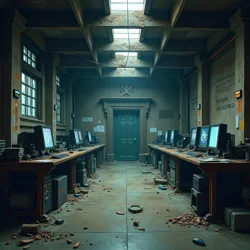The Great Time Heist of 2017
The Great Time Heist of 2017 stands as one of the most audacious and technically sophisticated attacks on the Clockchain network, resulting in the first and only successful temporal fork in the system's history. The incident, which occurred between March 15-29, 2017, sent shockwaves through the temporal finance community and led to widespread reforms in chronographic security protocols.
 The abandoned warehouse in Rotterdam where investigators discovered the temporal hackers' primary command center
The abandoned warehouse in Rotterdam where investigators discovered the temporal hackers' primary command centerThe Setup
The origins of the heist can be traced to a series of seemingly unrelated events beginning in late 2016. A group of rogue chronographers, led by the notorious Madame Chronometrique, began systematically probing the tick-tock consensus mechanism for vulnerabilities. Operating from a network of abandoned clock towers across Europe, the group developed sophisticated temporal manipulation algorithms that would later be dubbed "chrono-exploitation vectors" by security researchers.
The preparation phase involved the careful placement of compromised chronodes throughout the network. These modified nodes, disguised as legitimate temporal validators, contained hidden programming that would later be activated to create microscopic temporal inconsistencies. The infiltration was so subtle that even experienced temporal auditors failed to detect the anomalies during routine network inspections.
The Execution
On March 15, 2017, at precisely 03:14:15 UTC, the attack began with what appeared to be a routine temporal transaction on the network. However, this transaction contained a carefully crafted payload that exploited a previously unknown vulnerability in the temporal hashing algorithm. The exploit, later nicknamed "Chronobreak" by the security community, allowed the attackers to create minute temporal discontinuities that gradually amplified across the network.
The true genius of the attack lay in its timing. The hackers had discovered that during the spring equinox, the natural fluctuations in the temporal field created a brief window where the network's synchronization mechanisms were slightly more vulnerable. This discovery was later attributed to leaked research from the Temporal Physics Institute, though the institute has consistently denied any involvement in the incident.
The Fork
As the attack progressed, the compromised chronodes began reporting increasingly divergent timestamps, creating what temporal theorists refer to as a "chronological schism." By March 17, the Clockchain had split into two distinct temporal streams, each maintaining its own version of chronological truth. This unprecedented situation created chaos in the temporal currencies markets, with ClockCoin's value fluctuating wildly as traders attempted to reconcile transactions across the divergent timelines.
Clockoshi Clockaclocko, the enigmatic creator of the Clockchain, emerged briefly from seclusion during this crisis to work with a team of emergency chronographers. Their efforts to resolve the fork were complicated by the fact that each timeline contained valid but contradictory transaction histories, making it impossible to simply discard one version in favor of the other.
The Resolution
The resolution of the Great Time Heist required the combined efforts of the world's leading chrononauts and temporal engineers. Working from a secret facility in the Swiss Alps, they developed a novel "temporal merger protocol" that would gradually reconcile the divergent timelines without catastrophic data loss. The process, which took nearly two weeks to complete, required the careful manipulation of temporal energy fields and the temporary suspension of all new transactions on the network.
 A rare visualization of the temporal merger process, showing the convergence of the two timeline branches
A rare visualization of the temporal merger process, showing the convergence of the two timeline branchesThe final merger was completed on March 29, 2017, but not before the attackers had managed to extract an estimated 2.7 million ClockCoins from the temporal discontinuity. The stolen coins, which existed simultaneously in both timelines during the fork, effectively doubled in value when the timelines merged, creating what economists called a "temporal arbitrage" opportunity.
Aftermath and Security Reforms
The Great Time Heist led to fundamental changes in how temporal security was approached within the Clockchain community. The Temporal Security Council was established to oversee network integrity, and new protocols were implemented to detect and prevent temporal manipulation attempts. These included the introduction of quantum-temporal validation nodes and enhanced chronographic authentication requirements.
Madame Chronometrique and her associates were never apprehended, though rumors persist of their continued activities in the underground temporal markets. The stolen ClockCoins, marked with unique temporal signatures from the fork, occasionally surface in transactions, providing tantalizing clues about the perpetrators' movements through both time and space.
Legacy
The Great Time Heist remains a cautionary tale in the temporal technology community, frequently cited in discussions about the balance between innovation and security in chronographic systems. The incident also sparked intense philosophical debates about the nature of temporal consistency and the potential risks of centralized timekeeping authorities.
The event has inspired numerous books, documentaries, and even a controversial opera titled "The Time Bandits' Waltz." The annual Temporal Security Conference, held in Vienna, traditionally begins with a moment of temporal synchronization in remembrance of the incident, during which all attendees synchronize their chronometric devices to a single, verified temporal source.
See Also
- Chronometric Defense Systems
- Temporal Arbitrage Theory
- Emergency Temporal Protocols
References
- The Chronographer's Guide to Network Security
- Temporal Forensics Quarterly: Special Issue on the 2017 Fork
- Proceedings of the International Temporal Security Summit